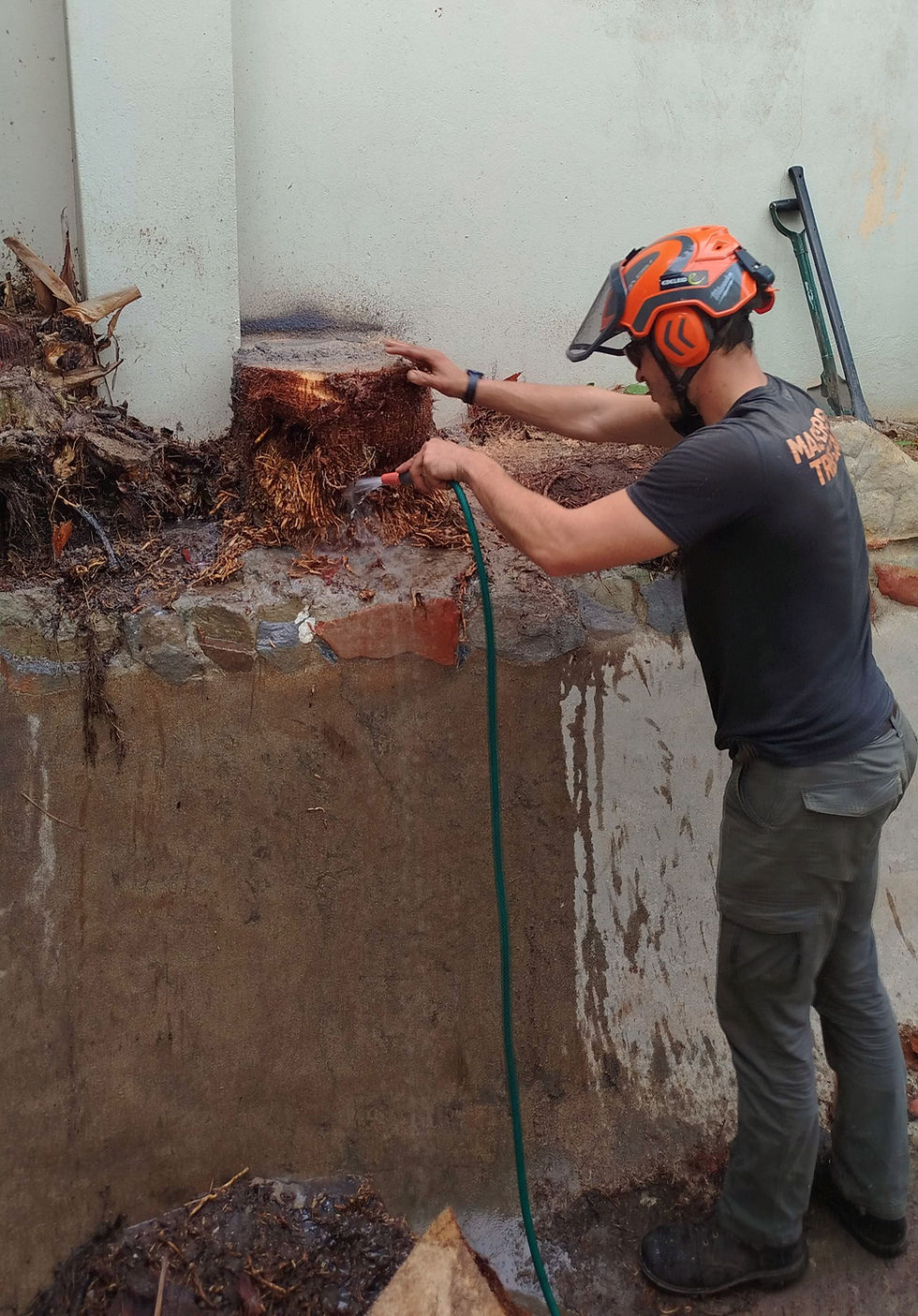How to Avoid Common Tree Mistakes in the Western Cape
- Marne Truter
- Jul 14
- 4 min read
Updated: Sep 9
Why Can Tree Care Mistakes Cost You Money?
Trees are a valuable part of any property, offering shade, beauty, and even increasing property value. However, in the Western Cape, where extreme weather conditions and specific soil types play a crucial role, improper tree care can lead to expensive consequences, including property damage, legal fines, and safety hazards.
Whether you're a homeowner, landscaper, or property manager, avoiding these common mistakes will save you time, money, and potential headaches down the road.

1. Can You Plant a Tree in the Wrong Spot? YES!
Not all trees thrive in the Western Cape’s climate.
Some species struggle with the hot, dry summers, while others have aggressive root systems that damage foundations and plumbing.
Common issues:
Planting water-thirsty trees in drought-prone areas.
Choosing fast-growing species with weak wood prone to breakage.
Placing large trees too close to buildings, power lines, or underground pipes.
How to fix it:
Choose indigenous or drought-resistant trees like Wild Olive (Olea europaea subsp. africana) or Cape Ash (Ekebergia capensis).
Consult a professional arborist to select the best tree for your location.
Follow proper spacing guidelines to avoid future structural damage.
2. What Happens When You Ignore Regular Tree Maintenance?
Neglected trees become overgrown, diseased, and structurally unstable, increasing the risk of falling branches or complete tree failure, especially during strong Cape winds.
In a forest, this is fine, but when the trees are in residential areas, it can be a big problem.
Common issues:
Dead or diseased branches that fall unexpectedly (Happens a lot with Oaks)
Thick canopies that block sunlight and airflow can lead to fungal growth.
Weak or unstable limbs that pose a hazard during storms. (We often see this in Eucalyptus trees)
How to fix it:
Schedule professional pruning at least once a year.
Remove deadwood and thin out dense canopies to improve airflow.
Hire a professional arborist to inspect trees for signs of disease or structural weakness.

3. What is the issue with Over-Pruning or “Topping” Your Trees?
Many property owners believe aggressive pruning or cutting the tops off trees (topping) will control growth.
In most cases, this weakens the tree, making it more vulnerable to disease and decay. Some trees respond better to pollarding (another name for topping),
Common issues:
Excessive pruning removes too many leaves, reducing the tree’s ability to produce energy.
Topping causes weak, rapid regrowth that is more prone to breaking.
Increases stress, making trees susceptible to pests and diseases.
How to fix it:
Follow proper pruning techniques that remove only necessary branches while maintaining the tree’s natural shape.
Never remove more than 25% of a tree’s canopy at once.
Work with a professional arborist who understands correct pruning methods, like pollarding.
4. Why Should I Monitor My Tree’s Health?
Tree diseases and pests can spread rapidly, causing irreversible damage and even leading to the loss of an entire tree.
Trees that are stressed due to environmental factors attract more pests and diseases (nature's built-in clean-up system). Pest-infested and diseased trees are almost always preventable.
Common issues:
Invasive pests like the Polyphagous Shot Hole Borer (Euwallacea fornicatus) attack stressed trees.
Fungal infections like root rot weaken the tree’s structure.
Failing to recognize early warning signs of decline.
How to fix it:
Regularly inspect trees for signs of disease (wilting leaves, unusual holes, or fungal growth).
Keep trees well-hydrated and fertilized to boost natural defences.
Contact an arborist immediately if you suspect a pest or disease problem.

5. What Happens If I Plant Trees Too Close to Buildings or Power Lines?
Improper tree placement leads to long-term structural and legal issues, as trees encroach on homes, walls, and power lines.
This often causes long battles with the municipality, which is never fun…
Common issues:
Roots damage foundations, driveways, and underground pipes.
Branches interfering with electrical lines create fire hazards.
The need for expensive removals or trimming later on.
How to fix it:
Always plant large trees at least 5 meters away from structures.
Choose small or medium-sized trees or bushes for spaces near buildings.
Consult an arborist before planting near infrastructure.
6. Can I Water My Trees Wrong?
Both overwatering and underwatering can weaken trees, making them more vulnerable to stress and disease. It is important to keep an eye on the moisture level of the soil and to understand the species of trees that you have in your garden.
Common issues:
Overwatering suffocates roots and encourages fungal infections.
Underwatering leads to weak, brittle branches prone to breakage.
Inconsistent watering schedules cause stress and irregular growth.
How to fix it:
Water deeply but infrequently, ensuring moisture reaches the roots.
Mulch around the base to retain moisture and regulate soil temperature. (Don’t heap up the mulch around the root
Adjust watering frequency based on the season and rainfall levels.

7. How Can DIY Tree Removals Go Wrong?
It is crazy that we still have to say this, but people STILL try to backyard mechanic their tree removals….
Removing a tree, especially a large or dangerous one, is one of the most hazardous tasks a property owner can attempt without professional help.
Common issues:
Risk of injury from falling branches or incorrect cutting techniques.
Damage to property, vehicles, or surrounding trees.
Legal liability if a tree falls onto a neighbour’s property.
How to fix it:
Always hire a tree removal expert for dangerous or large trees.
Ensure stump removal to prevent regrowth and pest infestations.
Obtain any necessary permits before removing protected tree species.
Protect Your Property by Avoiding These Mistakes
Proper tree care is essential for maintaining safety and preserving property value. Avoiding these common mistakes will help ensure your trees stay healthy and problem-free for years to come.
Worried about a tree in your garden?
📱 WhatsApp us directly: 072 455 8345





Comments